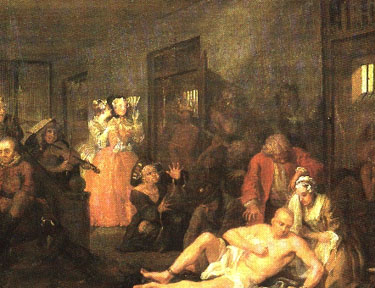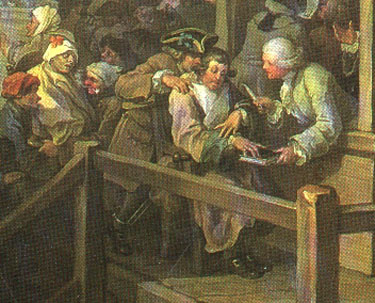|
|
|
IDIOTS,IMBECILES AND INTELLECTUAL IMPAIRMENT by Catherine Slater, M.A. Cantab
A History of Mental Handicap/Learning Difficulties from 1000AD to 2000AD-
This site is about the history of people who have been described over the years as fools and intellectually impaired, mentally retarded and developmentally delayed, mentally handicapped and learning disabled, They have faced oppression and prejudice in the past but now are beginning to be recognised as individuals who should be included , respected and valued who have equal civil rights and who are unique indivuduals who can offer a great deal and live rich fulfilled lives just like anyone else.I apologise to anyone who objects to my use of terminology that was used in the past but I need to use the old terms when I am describing the old times.

Many paintings of the Renaissance , show infants and children with Downs Syndrome depicted as cherubs and the infant Jesus. Various explanation have been put forward. Some have said that people with mental or physical disabilities were all part of Gods order blessed infants of their good God, and had a special place alongside popes, bishops, kings noblemen and knights. .People believed they would gain the favour of God by giving help and compassion to them.
If this were true , it would have been a golden age where handicapped people were not only socially accepted but taken as models of divine and saintly beings. Unfortunately this theory is not entirely true. During the sixteenth and seventeenth century there are two views of disabled people ,either related to Satan or innocents unstained by normal and sinful human characteristics.
In 1480, a book about witches. The Mallus Malificorum was published and read widely .In some areas where there was great superstition , women who gave birth to a disabled child were sometimes killed or exiled. They believed that a baby with a deformity or mental handicap was not the baby that was born to its mother but a replacement left by fairies and demons. This view was adapted from pagan folklore and Christianised explanations of the story were that the parents were guilty of some wickedness, or that the parents loved the child more than they loved God or that the mother had been seduced by the devil. Superstition held that a disabled, or deformed child was bad luck a curse divine retribution or that disability indicated possession by the devil or was the outcome of evil-doing..
Martin Lutherís met a boy who may well have had Prader-Willi syndrome. He was 12 years old had the use of his eyes and all his senses so one might have thought that he was a normal child but he did nothing but gorge himself as much as four peasant or threshers. Luther suggested that he should be drowned as he had no soul, but as a substitute he recommended prayer that the Lord take the Devil away.. The child died the following year.
During the middle ages and into the 16th century people with physical defects, like hunchbacks or dwarfs, and people with simple minds were often kept as court jesters and fools. There is a tradition that Tycho Brahe(1546-1601) the astronomer had as a close companion an imbecile to whose mutterings the astronomer listened to as divine revelations.
Paracelsus, a Swiss physician(1493-1541) who revolutionised medical research and made it scientific wrote about mental disability , as did others. A herbal from the time describes a remedy for idiocy and folly: Put into ale -cassia ,and lupins, bishopwort, alexandrin, githrife fieldmore and holy water and let it be drunk.
The Dissolution of the monasteries and economic changes meant someone else had to provide social welfare for increased numbers of destitute people including some who had mental disabilities who relied on begging or charity. The Elizabethan Poor law made it a duty of the parish to care for those unable to work., but also stressed that those who could work should work. distinction between the deserving and the undeserving poor. here was punishment for able bodied people who refused to work and Parish relief for those in genuine need.
Mentally disabled people would have been cared for my members of the family but if the breadwinner died, or the family fell on hard times they could claim relief from the parish. 17th and 18th century parish records mention people with learning disabilities describing them as idiot, stupid, innocent, witless. Different phrases like crazy or mad were used for mentally ill people. if the primary carer died then person could be the legal obligation of parish .and be looked after by the Parish nurse.or other parishioners.Sometimes they would receive a clothing allowance.
.Bethlem or Bedlam Hospital was transferred to the City of London. In 1598 a committee appointed to inspect Bethlem found it " so loathsomely and filthy kept , not fitt for anye man to come into the sayd howse." there was an attitude that people who placed lunatics or idiots in Bedlam ought to pay for their upkeep.It was now felt that families who couldnít look after the mentally disabled person themselves should pay towards their upkeep and care elsewhere.
. Sometimes the mentally handicapped person was cared for in his own lodgings by a servant the beginning of private lunatic asylums. William Harvey had a nephew William forbes who was an idiot. .In early 16th century the majority of hospitals were almshouses and leper houses which did not provide medical care. During the seventeenth century hospitals providing care for the sick increased in number During the eighteenth century ,specialist hospitals especially lying in hospitals became more common as did institutions into which the mad were detained Since madness was not seen as a medical problem ,these institutions were refuges rather than hospitals in the modern sense. 1615 in a legal dictionary, " an exposition of certain difficult and obscure terms Ö. States "Idiot is he that is a fool natural from birth and know not how to account or number 20 pence nor cannot name his father or mother nor of what age himself is or such like easy and common matters so that it appears that he has no manner or understanding or reason nor government of himself whether it is for his profit or disprofit." In the 1650ís the managers of Bedlam tried to make a distinction between the curable mad and "those dangerous to be abroad" who should be in a hospital and harmless idiots who should not be.Iit would be necessary to certify those who were lunatic .A subcommittee was set up to identify and eject those who were idiots and not lunatic.Bedlam was rebuilt in 1676.

1720 John Strype of Bethlehem said that people who were raving and furious and capable of cure were welcome at Bethlehem and if not those that are likely to do mischief to themselves or others whoare poor and cannot otherwise be provided for. but those who are only melancholic or idiots and judged not capable of cure these the governors of the house might not be burdened with. Bethlehem hospital provided Sunday afternoon entertainment for many decades from the end of the seventeenth century The chained patients were placed in cells and galleries like chained animals in a menagerie The asylum received large sums of money from the visitors until 1770 when it was decided that they tended to disturb the tranquillity of the patients by making sport and diversion of the miserable inhabitants and that admission should be by ticket only.. The public flocked to view the lunatics in the madhouse many of whom if classified today would be generally described as having mental handicaps or mental disabilities

Children were sometimes abandoned by parents for a variety of reasons including disability .Between 1690 and 1720 a thousand children a year were abandoned . The Foundling Hospital in London was opened in 1741 as a first step towards reducing the very high mortality rates among deserted children. Other foundling hospitals were established in an attempt to combat infanticide and as part of the general scheme to recognise poor relief and care for the mentally and physically disabled. .Boys outnumbered girls and most were abandoned in the winter. Religious or quasi religious explanations for insanity gave way increasingly to psychological and physiological explanations . By the eighteenth century neurological and psychiatric conditions were beginning to be recognised separately and in their own right ideas.Ideas of possession by evil spirits or astrological explanations gave way to explanations based upon age or stage of life or physiological condition.

Idiocy or ideocy now the common scientific term for mental retardation although word dunce being use by educators and by lay people. In 1798 Itard in Paris tried to educate " the wild boy of Aveyron" and gave some account of the psychology of mental handicap During the industrial revolution there was a great demand for child labour . In the eighteenth century children were often bonded out to mill owners . The parish authority often bargained with the mill owner to take on idiot with every 20 children . What became of the idiots is not known but it most areas they did not last long and mysteriously disappeared
With acknoweledgements to the book From idiocy to mental deficiency: historical perspectives on people with learning disabilities/ edited by David Wright and Anne Digby London: Routledge, 1996 , an extremely useful resource.Also A history of mental retardation / R.C. Scheerenberger Imprint Baltimore : P.H. Brookes Pub. Co., c1983
.Coming next
Next Chapter Three Segregation,incarceration and Eugenics
 World Association of persons with disabilities
World Association of persons with disabilities
